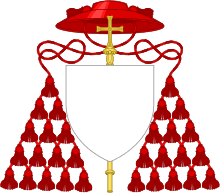Giacomo Lercaro
| Styles of Giacomo Lercaro | |
|---|---|
 | |
| Reference style | His Eminence |
| Spoken style | Your Eminence |
| Informal style | Cardinal |
| See | Bologna |
Giacomo Lercaro (October 28, 1891 – October 18, 1976) was an Italian Cardinal of the Roman Catholic Church who served as Archbishop of Ravenna from 1947 to 1952, and Archbishop of Bologna from 1952 to 1968. Lercaro was elevated to the cardinalate in 1953 by Pope Pius XII.
Biography

Early life and ordination
Giacomo Lercaro was born in Quinto al Mare, Genoa, as the eighth of nine children. He came from a family of seamen, and two of his brothers, Amedeo and Attilio, also entered religion. From 1902 to 1914, Lercaro attended the archdiocesan seminary in Genoa. He was ordained a priest on July 25, 1914 by Archbishop Ildefonso Pisani, and four months later, in November, traveled to Rome to study at the Pontifical Biblical Institute.
Pastoral and theological work
When Italy entered World War I, Lercaro was forced to change posts and become a military chaplain until the war ended in 1917. In 1918, he became Prefect of the Seminary of Genoa, where his brother Amedeo was rector, and would remain in that post until 1923. He also served as substitute professor of theology (1921–1923) and professor of Sacred Scripture and Patrology (1923–1927). In 1927 he became a teacher of religion in secondary school and became involved in numerous student movements in the Genoa district.
Archbishop
He received his episcopal consecration on March 19, 1947 from Archbishop Giuseppe Siri, with Archbishop Angleo Rossini and Bishop Francesco Canessa serving as co-consecrators. In the consistory of January 12, 1953, Lercaro was created Cardinal-Priest of Santa Maria in Traspontina by Pius XII.
Cardinal
During his early years as a cardinal, Lercaro established his first contacts with Angelo Roncalli and became well known for the way in which he turned his episcopal palace into an orphanage. Although he had been seen by Vatican-watchers ever since 1953 as a possible successor to Pius XII and was listed by l'Osservatore Romano as a papabile, his reputation as the most idiosyncratic of all the Cardinals and the desire for a transitional pontiff saw him passed over.
Generally considered papabile in the 1963 papal conclave closest to the vision of John XXIII, Lercaro, however, was considered too liberal by most of his fellow cardinal electors to be elected; Giovanni Battista Montini ultimately won.
Although Cardinal Lercaro did much vital work in implementing the Council after it closed in 1965, his advancing age saw him gradually disappear from prominence within the Church as the 1960s drew to a close. On February 12, 1968, Cardinal Lercaro stepped down from his position as Archbishop of Bologna and in 1971, he lost his right to participate in any future conclave upon reaching the age of eighty according to the then-recent motu proprio Ingravescentem aetatem.
Death
Lercaro died from a cardiac crisis in Bologna, ten days short of his 85th birthday. He was buried in the metropolitan cathedral of that city.
Views
Anti-fascism
His involvement in these student movements gave Lercaro a great interest in engaging Catholic theology with modern culture, and during the war he became one of the most prominent anti-Fascists within the Church, preaching steadfastly against Nazism and offering support in his home for those persecuted by Mussolini—most notably for Italian Jews whose persecution began as a result of Italy's collaboration with Nazi Germany. At one point during World War II Lercaro was forced to operate under the alias of "Father Lorenzo Gusmini" and live in a vacant monastery cell to avoid being killed by Nazi collaborators.
Anti-communism
Lercaro's reputation as an outspoken critic of Communism is believed to be a contributing factor in Pope Pius XII's decision to make him the first Archbishop of Ravenna (January 31, 1947) and then the twentieth Archbishop of Bologna (April 19, 1952), both considered among the largest Italian cities under Communist rule.
Second Vatican Council
Even though Lercaro felt that Pope John was moving much too quickly when he first announced the Second Vatican Council in late 1959, he later sat on its Board of Presidency and became regarded as one of the main architects of the Council's liturgical reforms.
Church of the poor
Cardinal Lercaro was also the first to popularise the theory of a "Church of the poor" that developed further in Latin America during the 1970s. During his tenure as archbishop of Bologna, where the most popular political party was the Italian Communist Party, he tried to build a dialogue with the members of this party.
External links
- Cardinals of the Holy Roman Church biography
- Catholic-Hierarchy profile
- TIME Magazine - Who Fired the Cardinal?
- TIME Magazine - The Cardinal's Comeback
|